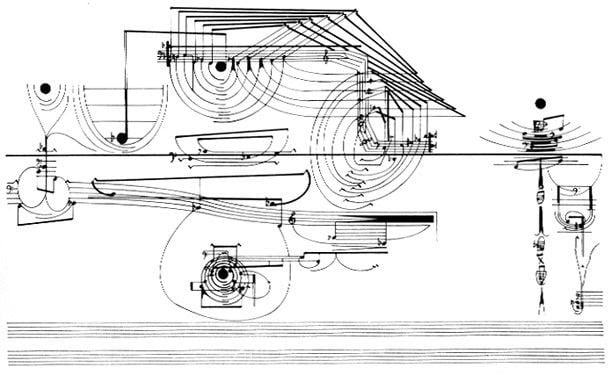Students often compose really interesting rhythms…but then have trouble figuring out how to notate them. In this article and podcast episode, I’ll help you as you help your students with complex rhythm dictation.

⬆️ Listen to the podcast above or keep on reading, whichever fits your style. ↙️
Is your student up against a wall when it comes to transcribing rhythms? As with reading rhythms, being able to write rhythms is a skill which needs to be practised deliberately over time.
The good news is that if you take the time to help students with rhythm dictation, they’ll learn many complementary skills in the process.
Being able to notate complex rhythms is an excellent exercise in ear training and aural memory. It will also strengthen your students’ pattern recognition abilities.
But if we just dive straight in, the result will be student overwhelm.
Here are some ways we can help students get those intricate rhythms out of their head and onto the page.
Rhythm Foundations
Before you can help your students with complex rhythm dictation, you need to ensure they have some basic rhythm skills.
March On
A sense of pulse is one of the most fundamental skills your student needs in order to succeed with rhythm activities.
For some children, this develops very early on. Others will need lots of practice marching, tapping and dancing to the beat with you.
Build a Rhythm Vocabulary
Your goal as a teacher shouldn’t just be centred around having students read rhythms. When everything is about decoding notation, they’ll tend to get stuck when they try to go the other direction.

Instead, put your focus on developing their rhythm vocabulary. They need to internalise common rhythm patterns and then associate these with the matching notation so that they can bridge the gap between the feeling and the symbols.
Divide and Conquer
Even just the word “rhythm” can be confusing for some students. Make sure to include lots of activities to separate out rhythm, beat, and pitch.
You’ll find lots more rhythm games and activities to strengthen these skills in my book, Rhythm in 5.
Notating Complex Rhythms
Now that we have the basics down, here’s a step-by-step process you can use to help your students with rhythm dictation.
Step 1: Long or Short
The first thing your student will need to figure out is where the long notes are and where the short notes are.
This is more challenging than it sounds for many kiddos. If your student needs a tactile way to puzzle this out, try this:
- Choose 2 sets of objects to represent the long and short notes. For example, paperclips are short and pencils are long.
- Have your student tap their rhythm several times and then count the number of notes there are.
- Then ask them whether the first note is a long one or a short one and put the matching token in front of them.
- Continue to the next note, and so on, until you have a line of paperclips and pencils to match the rhythm they composed.
- Clap the rhythm together to make sure your pattern matches.
Their rhythm will probably have more than 2 note values, and that’s totally fine. By categorising each note as either long or short we’re just starting the process of figuring out the pattern.
Step 2: Strong or Weak
The next thing your student will need is the time signature. But in order to get there, they need to know where the strong beats are.
Have your student tap their rhythm again but with a stronger tap at the places where they feel the main beats. If they’re having trouble you can demonstrate clapping with the strong notes in different places, and they can see which one sounds right to them.
If you’ve been using the pencil and paperclip method above, you can place something else (e.g. erasers) underneath the strong beats as you find them.
From there, your student may be able to figure out the time signature themselves. If they can’t, you might step in suggesting a suitable one.
Step 3: Hypothesise
Now that they have a rough template, your student can make guesses at what the long and short notes might be and put them to the test.

Get them to write the rhythm out and either:
- Put it into notation software and have it played back to them.
- Clap it as if it’s a brand-new rhythm. They may need to use a metronome to keep from simply clapping the way they want it to go.
- Have you clap and count it to see if it sounds right.
If it doesn’t sound right, no problem. That’s part of the process. They just need to go back to the template and figure out another solution or tweak the rhythm pattern if it’s only off by a little bit.
Troubleshooting Tips
Sounds easy, doesn’t it? Just 1, 2, 3 and your student’s complicated rhythm has been perfectly notated.
It doesn’t always happen that smoothly. Here a few tips to help you and your student avoid frustration when transcribing rhythms.
Sloooooow Motion
Slow it down. Yes, it might be a fast passage but just as when we’re reading, if we can slow the pulse right down we give our ears a chance to catch up.
Grid Method
Breaking the pulse into quavers or semiquavers (eighth notes or sixteenth notes) can help us see where the rhythm fits.
Familiar Patterns
Get your student to ask themself if they’ve heard all or part of their rhythm pattern in a piece before. They can then look up the notation for that piece and work from there.
Swung or Straight
Sometimes the reason it doesn’t sound right is that it ain’t got that swing! Teach your student about swing and the effect it has on quavers (eighth notes).
Ornaments
If their rhythm has little twiddly bits they’ve been trying to notate, those might be ornaments instead. Help them figure out which ornaments to put in at those points.
You’ll find all sorts of resources about rhythm and notation on my Music Theory hub page.
When Your Student Can’t Transcribe Their Rhythm
Step In
If we’ve had a good crack and no solution is found, it might be better to step in and notate the rhythm for them. We don’t want frustration to put them off composing, and they’ll get better at rhythm dictation with time and practice.
Invented Notation
Maybe your student can think of a more visual or literal way to explain what they mean. Could they use pictures, a story, numbers to describe what they want?
Western notation isn’t the be-all-and-end-all of notation. Although it does a good job, it’s far from perfect and can never encompass all that it is to express music.

This could be a good opportunity to get those creative juices flowing, offer an alternative view and discuss music notation in the world. You could also break out this wonderful book, if you have it, to prompt further discussion.
At the end of the day, notating music is an interpretation of a composer’s thoughts and intentions. Oftentimes a composer’s written music is not a literal translation of the music they created in their head.
Many musical traditions don’t write any music at all. Or if they do, they use a very simplified form which doesn’t contain all the ‘musical code’ musicians learn from being in that culture.
What struggles do your students face when they have complicated rhythms in their compositions?
I’d love to hear your thoughts on this in the comments below. 🙂
